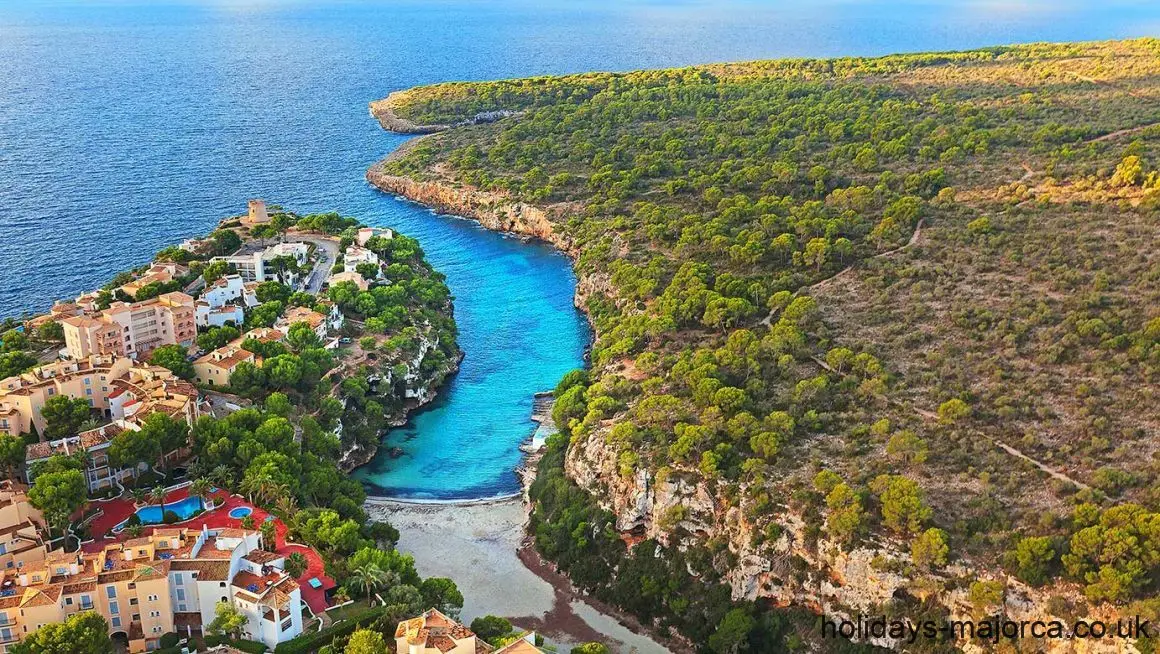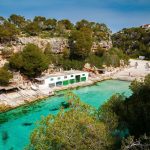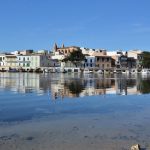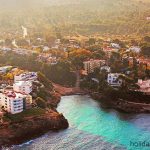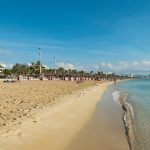Table of Contents
Cala Pi is a small & beautiful cove enclosed between cliffs next to the village of the same name in the municipality of Llucmajor, south of Mallorca.
Cala Pi is the perfect choice for calm, tranquillity & relaxation.
The earliest known settlement in Mallorca, ironically it remains one of the least exploited locations on the island.
Cala Pi is a natural harbour on the south coast of the Lluchmajor district & is about forty kilometres drive from Palma’s Son Sant Joan airport.
In fact, it’s the largest cove on the south of the island.
It extends about 500m into the shore and is surrounded on both sides by 30m-high cliffs covered with pine trees.
The cove is formed by the Cala Pi torrent, which creates a sandy beach at the mouth where it meets the sea, which is just 50m wide and 150m long.
The ruggedness of the surrounding terrain has meant that there is little urbanisation.
This means that the environment is largely undisturbed, making it a calm haven of natural beauty.
About Cala Pi
Once on the beach, it is often calm and ideal for spending a day with the family enjoying its seas, gorgeous natural surroundings, and neighbouring attractions.
Cala Pi features a lifeguard service, beach umbrellas, and sun loungers for hire during the summer months, but there’s plenty of space to stretch out your towel.
There’s also a tiny beach bar with restrooms where you can get soft drinks, ice cream, or a snack at a reasonable price.
There are several dry docks erected in the 1950s at one end of the beach where small boats may be washed or stored.
This little town is a popular tourist destination, yet it welcomes tourists to unwind and enjoy the peace and quiet.
There is only one church in the town, named Nostra Senyora des Angels.
History & Culture Of Cala Pi
The refuge from the weather given by this natural harbour is said to be what drew the earliest residents of Mallorca to Cala Pi.
Because of the rocky shoreline, large-scale building is difficult, thus this little community remains a peaceful resort for visitors seeking natural beauty.
Cala Pi is noted for its crystal-clear waters, but it also features a Bronze Age village, Capocorb Vell, which is one of the most important archaeological sites on the island.
The Bronze Age village of ‘Capocorb Vell’, some 5 kilometres away, may still be visited.
Cala Pi is a small and simple community with just the church of Nostra Senyora des Angels and a few hotels, stores, and restaurants.
The small streets run parallel to the coast, and the beach is only accessible via stairs.
Due to the steep inclines and countless stairs located throughout the region, Cala Pi is not a good choice for anyone with mobility issues.
Cala Pi is unquestionably best experienced on foot.
The beach has lifeguards and services that make it excellent for families, but it is also good for couples, parties, and solo travellers.
During peak season, the beach may get rather crowded, although it is not a place to go for late-night partying and noise.
Shopping In Cala Pi
Cala Pi is not the best place to buy, even though you can find enough products for your holiday and day-to-day necessities.
Those looking to spend a day shopping should head to the nearest town, Lluchmajor, or the capital, Palma.
Main Attractions In Cala Pi
Cala Pi’s major draw is its beach and shoreline, but getting there requires a 147-step descent.
It is a beautiful beach enclosed between two natural cliffs.
This creates beautiful vistas of the contrast between the sandy beach, crystal blue seas, dramatic boulders, and lush flora.
The beach & cove are only 50 metres wide but stretch out to sea for about 100 metres, making it feel very sheltered.
Cala Pi, which offers adequate protection from the weather, also draws a large number of luxury boats, which dock in the port.
Cala Pi beach, despite its remote location, may be extremely busy during the high season, especially on weekends, since it attracts both visitors and residents.
There are plenty of additional sights nearby, but you will almost definitely need to rent a car or schedule an organised tour.
There are several bustling resorts, natural parks, wineries, and attractive tiny towns to visit in Mallorca’s southeast.
The award-winning beach of Es Trenc, near Ses Covetes, and the Cabrera natural reserve’s islands, just a few kilometres off the south coast, should also be mentioned.
Things To Do In Cala Pi
Cala Pi is likely to be the first choice for people looking to get away from it all.
After relaxing on the beach, you can explore the surrounding region by sailing, water sports, hiking, or cycling.
There are various locations of interest for hikers, including a watchtower erected to guard against pirates.
Before travelling down to the beach, you may see the Cala Pi defence tower, which dates back to 1663 and has just been renovated.
You may also go scuba diving but proceed with caution owing to the enormous number of vessels that may gather in the area.
Cala Pi is ideal for practising deep-water soloing (psicobloc).
It has had marked pathways for the practice of this sport since 2018.
From here, you may visit Cala Beltrán by a road that begins adjacent to the fishermen’s homes and leads to the historic Cap Blanc defence tower.
Along the route, you can see some dolines formed by the collapse of caves, some of which were inhabited in prehistoric times.
You can also walk through the grounds of the old military zone, where the old coastal batteries that guarded the bay of Palma were located.
Events In Cala Pi
Cala Pi is so quiet that you have to travel to Lluchmajor or Palma to find local festivals & events.
Restaurants In Cala Pi
In Cala Pi there are a small selection of bars & restaurants to choose from.
However, if you are looking for top-quality gastronomy, a short trip will lead you to some excellent rural restaurants & boutique hotels.
Hotels In Cala Pi
Accommodation in Cala Pi is limited so if you want to spend your holiday here it’s best to book as early as possible.
Living In Cala Pi
Cala Pi is very attractive to those seeking the beauty of nature but is more popular as a holiday resort than as a full-time residence.
Due to the difficulties of building here, there are still plots of land for sale.
Prices are more reasonable than in other parts of the island, such as the southwest.
Houses & flats are available for less than 100,000 euros.
Penthouses and villas sell for around 400,000 euros.
A high-quality villa could cost around three million euros & there are fewer fincas here than further north in rural Mallorca.
Location of Cala Pi
Cala Pi is located on Mallorca’s south coast, 17 kilometres from the town of Llucmajor.
The airport at Palmas San Joan is only 40 kilometres away.
Take the motorway from Palma to Llucmajor, exit 13, and continue along the Cap Blanc route.
Then another 30 kilometres to our goal.
Cala Pi Beach
Cala Pi is the name of the beach in the village of the same name.
It is situated between two pine-forested cliffs.
The beach features golden sand and blue waters, however, there are also stones and some boulders.
There isn’t much swell because it’s so protected.
This beach extends 500 metres inland between two 20-meter-high vertical cliffs.
It features fine sand, a shallow gradient, and is flanked by a residential neighbourhood.
Its casual atmosphere draws both local and foreign tourists, and it is suitable for everyone except those who require wheelchair access.
The main drawback is that it might be difficult to find a space on the beach during peak season.
Cala Pi Services
There is a beach bar on the sand, but the restaurant is up several stairs on the hillside.
In peak season, the cove offers a lifeguard service as well as sun loungers and parasols for rent.
Camping and animals are not permitted.
Parking is easy to find in the village.
The Surroundings Of Cala Pi
Llucmajor, around 30 kilometres from Palma de Mallorca, is the closest town to Cala Pi.
From there, continue the Ma-6015 road for about 15 kilometres until you reach a junction (well marked) where you turn right onto the Ma-6014 towards Cala Pi.
Travelling by boat is a common alternative.
This cove has been utilised as a sanctuary for the boats of Mallorca’s early residents from prehistoric times, at least since the Bronze Age.
However, owing to the presence of rocks near the surface approaching from the port side, care must be used when visiting the cove.
As a result, it’s best to enter the cove at the centre of the entrance.
If we want to get there by public transport line 525 connects Cala Pi with Llucmajor, El Arenal & Palma.
Around Cala Pi there are some small, quiet villages, such as Valgornera & Sa Vinyola.
Further east along the coast, more active spots can be found in Sa Rapita and Colonia de Sant Jordi, & the local wine region is centred around Felanitx.
Access
The easiest way to reach Cala Pi is by car.
However, there are also buses to the village.
There is free car parking.
By Boat
At the entrance to the cliffs there are three stones on the port side, so boats will have to access the central part of the cove to anchor.
This is only possible if you arrive early & your boat is not too large, as the depth inside the cove is between two & five metres on a sandy bottom.
The nearest port facility, the Club Náutico s’Estanyol de Migjorn, is 4 nautical miles from the cove.
Click to show map!

Mark Kaye is a travel writer and content creator living in Majorca, Spain. Originally from the UK, Mark moved to the island and quickly fell in love with Majorcan culture, food, and scenic landscapes. When he’s not busy writing detailed guides about Majorca’s top tourist attractions and hidden local gems, you can find him out exploring coastal trails or wandering the streets of Palma’s Old Town in search of his next great restaurant discovery.
